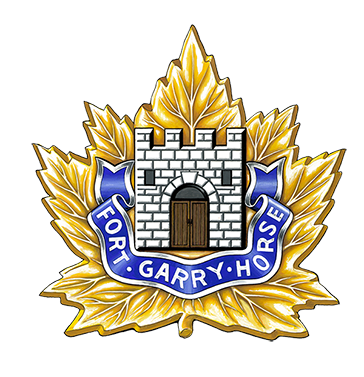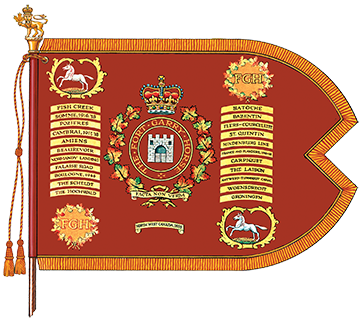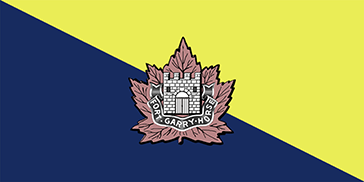The Fort Garry Horse
The official lineage of The Fort Garry Horse armour regiment.

Badge
Description
On a maple leaf Or the portal gate of Fort Garry proper above a scroll Azure edged and inscribed FORT GARRY HORSE in letters Argent.
Symbolism
The maple leaf represents service to Canada. The Fort Garry Gate of the former Hudson Bay's Company fort represents the City of Winnipeg. "FORT GARRY HORSE" is a form of the regimental title.
Motto
FACTA NON VERBA (Deeds not words)
Marches
Quick Marches
El Abanico; and St. Patrick's Day
Slow March
Red River Valley
Alliance
British Army
The Royal Dragoon Guards
Guidon

Camp flag

Battle honours
North West Campaign
FISH CREEK; BATOCHE; NORTH WEST CANADA, 1885.
The First World War
SOMME, 1916, '18; Bazentin; Pozières; Flers-Courcelette; HILL 70; YPRES 1917; CAMBRAI, 1917, '18; St. Quentin; AMIENS; ARRAS, 1918; HINDENBURG LINE; St. Quentin Canal; Beaurevoir; PURSUIT TO MONS; FRANCE AND FLANDERS, 1916-18.
The Second World War
NORMANDY LANDING; CAEN; Carpiquet; FALAISE; Falaise Road; The Laison; Boulogne, 1944; Antwerp-Turnhout Canal; THE SCHELDT; Woensdrecht; THE RHINELAND; Goch-Calcar Road; The Hochwald; Groningen; Oldenburg, NORTH-WEST EUROPE, 1944-1945.
South-West Asia
AFGHANISTAN
Lineage
This Reserve Force regiment originated on 15 April 1912 and incorporates the following regiments.
The Fort Garry Horse originated in Winnipeg, Manitoba on 15 April 1912, when the '34th Regiment of Cavalry' was authorized to be formed.Footnote 1 It was redesignated: '34th "Fort Garry Horse"' on 2 January 1913;Footnote 2 and 'The Fort Garry Horse' on 15 March 1920.Footnote 3 On 15 December 1936, it was amalgamated with 'The Manitoba Horse' (see below) retaining its designation.Footnote 4 It was redesignated: '2nd Regiment, The Fort Garry Horse' on 13 August 1940;Footnote 5'2nd (Reserve), The Fort Garry Horse’ on 7 November 1940; Footnote 6 '10th (Reserve) Armoured Regiment, (The Fort Garry Horse)' on 1 April 1941;Footnote 7 '10th Armoured Regiment (The Fort Garry Horse)' on 31 January 1946;Footnote 8 'The Fort Garry Horse (10th Armoured Regiment)' on 4 February 1949;Footnote 9 'The Fort Garry Horse' on 19 May 1958;Footnote 10 'The 2nd Fort Garry Horse' on 11 October 1958;Footnote 11 'The Fort Garry Horse (Militia)' on 1 January 1960;Footnote 12 and 'The Fort Garry Horse' on 16 June 1970.Footnote 13
Notes:
On 1 November 1920 The Fort Garry Horse was organized as a two regiment unit with the 1st Regiment on the Non Permanent Active Militia order of battle, and the 2nd Regiment on the Reserve order of battle (GO 185/20). The reserve unit was disbanded on 14 December 1936 (GO 3/37).
The Fort Garry Horse was disbanded for the purpose of reorganization on 2 August 1920 and reorganized the same day (GO 172/20). This change was administrative and does not affect the lineage of the regiment.
The Fort Garry Horse were disbanded for the purpose amalgamation on 14 December 1936 and reorganized the next day (GO 160/36). This change was administrative and does not affect the lineage of the regiment.
On 15 May 1936, the regiment was assigned the perpetuation of the '226th "Overseas" Battalion, CEF' (GO 69/39).
On 11 October 1958, a Regular Force component was authorized under the designation 'The 1st Fort Garry Horse' (CAO 110-2, Pt 'B', Supp Issue No. 626/58). On 1 January 1960, it was redesignated 'The Fort Garry Horse' (CAO 76-2, Pt 'B', Supp Issue No 665/60). The Regular Force component was reduced to nil strength and placed on the Supplementary Order of battle on 16 June 1970 (CANCOMGEN 018/70).
The Manitoba Horse originated in Roblin, Manitoba on 1 April 1912, when the '32nd Light Horse' was authorized to be formed.Footnote 14 It was redesignated: '32nd Manitoba Horse' on 2 November 1912;Footnote 15 and 'The Manitoba Horse' on 15 March 1920.Footnote 16 On 15 December 1936, it was amalgamated with 'The Fort Garry Horse', as above.
Notes:
On 1 November 1920 The Manitoba Horse was organized as a two regiment unit with the 1st Regiment on the Non Permanent Active Militia order of battle, and the 2nd Regiment on the Reserve order of battle (GO 185/20). The reserve unit was disbanded on 14 December 1936 (GO 3/37).
The Manitoba Horse was disbanded for the purpose of reorganization on 1 June 1921 and reorganized the same day (GO 200/21). This change was administrative and does not affect the lineage of the regiment.
The Manitoba Horse was disbanded for the purpose of reorganization on 31 March 1925 and reorganized the same day (GO 31/26). This change was administrative and does not affect the lineage of the regiment.
On 15 July 1931, the 1st Regiment was redesignated the 1st Regiment (226th Battalion, CEF) (GO 94/31).
On 16 March 1932, the regiment was authorized to perpetuate 'Boulton's Mounted Corps' (GO 38/32).
The Manitoba Horse was disbanded for the purpose amalgamation on 14 December 1936 and reorganized the next day (GO 160/36). This change was administrative and does not affect the lineage of the regiment.
Perpetuations
'Boulton's Mounted Corps' of 1885; and '226th "Overseas" Battalion, CEF'
Headquarters Location
Winnipeg, Manitoba
Operational history
North West Campaign
Boulton's Mounted Corps was mobilized for active service on 10 April 1885.Footnote 17 It served with Middleton's Column of the North West Field Force.Footnote 18 The corps was disbanded on 18 September 1885.Footnote 19
The First World War
Details from the 32nd Manitoba Horse were placed on active service on 6 August 1914 for local protection duties.Footnote 20
Details from the 34th Fort Garry Horse were placed on active service on 6 August 1914 for local protection duties.Footnote 21
'The Fort Garry Horse, CEF' were organized in England on 21 January 1916.Footnote 22 It disembarked in France on 25 February 1916, where it fought in France and Flanders as part of the 1st Canadian Cavalry Brigade until the end of the war.Footnote 23 The regiment was disbanded on 6 November 1920.Footnote 24 The regiment also mobilized the '34th Fort Garry Horse Overseas Training Depot, CEF', which was authorized on 15 June 1917.Footnote 25 It was redesignated the '34th Fort Garry Horse, Depot Squadron, CEF' on 1 September 1917.Footnote 26 It embarked for Britain on 21 May 1917, where it provided reinforcements to the Canadian Corps in the field.Footnote 27 The squadron was disbanded on 6 November 1920.Footnote 28
The 226th Battalion, which was authorized on 15 July 1916 as the '226th "Overseas" Battalion, CEF',Footnote 29 embarked for Britain on 16 December 1916.Footnote 30 Its personnel were absorbed by the '14th Reserve Battalion, CEF' on 7 April 1917 to provide reinforcements for the Canadian Corps in the field.Footnote 31 The battalion was disbanded on 27 July 1917.Footnote 32
The Second World War
The regiment mobilized 'The Fort Garry Horse, CASF' for active service on 1 September 1939.Footnote 33 It was allocated to the Canadian Armoured Corps on 13 August 1940.Footnote 34It was redesignated: '10th Armoured Regiment (The Fort Garry Horse), CASF' on 11 February 1941;Footnote 35 '10th Armoured Regiment (The Fort Garry Horse), CAC, CASF' on 15 October 1943;Footnote 36 and '10th Armoured Regiment (The Fort Garry Horse), RCAC, CASF' on 2 August 1945.Footnote 37 The regiment embarked for Britain in November 1941.Footnote 38 The regiment landed in Normandy on 6 June 1944, as a part of the 2nd Canadian Armoured Brigade, in support of the 8th Infantry Brigade, 3rd Canadian Infantry Division, and fought in North-West Europe until the end of the war.Footnote 39 The overseas regiment was disbanded on 31 January 1946.Footnote 40
South-West Asia
From 2002 to 2014, The Fort Garry Horse reinforced various CAF units deployed to Afghanistan.Footnote 41